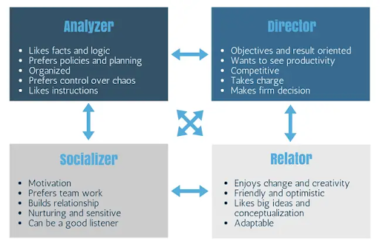To be a great leader, it’s not enough to be highly skilled in your chosen profession. Leadership itself is a skill.
Leadership is defined by being able to get people to follow you to achieve a common goal. It requires bringing different people together and getting them to work towards the realization of an established goal.
You can’t be a good leader without the ability to communicate effectively with your team members. Communication is the most important skill for leaders to have at all times.
It’s the primary medium through which great leaders motivate their teams and inspire positive action and disseminate information from one department to another.
Excellent communication in leadership is essential. In fact, the success of your project is often a function of how well you handle communication. In light of that, we’ll be exploring tips to help you communicate like great leaders.
Looking for online courses on learning new communication skills for your institution? The Infobase Learning Cloud can help.
Identify and Adapt Your Communication Style as Needed
The first thing you must discern upon entering a leadership role is your communication style. You have to determine the kind of image you’d like to present to your team members. Ask yourself these questions.
- What kind of communicator are you?
- What are your weaknesses in terms of communication?
- What are your strengths?
- What are your ideals?
Try to answer these questions. Then, you will have a better understanding of your existing communication style.
You will also have to decide if this is suitable for your new leadership role. If you decide it’s not suitable, adjust certain details as you see fit.
Don’t Be Afraid to Try New Things
Innovate your workspace with the use of an employee timesheet app or the use of VoIP.
In today’s digital world, there are so many ways to stay in touch with a project team. There’s email, text, video call, and more. You can even go as far as learning how VoIP phones work.
It could be useful, therefore, to learn how to use VoIP. One of the many benefits of VoIP is fast voice messaging that can help you communicate particularly effectively. To communicate like a great leader, you also need great technology at your disposal.
Understand Your Team
To influence someone, first seek to understand, and then be understood. It is important to understand the people you have been chosen to lead.
Remember, you are not doing this for yourself. You are adjusting your communication style to move the team forward.
You must learn what your team knows already and what they are used to. What is the existing company culture? Find out. This way, you can adjust your communication style accordingly.
By doing this, your message will be more engaging. You will be able to establish a strong connection with the team. In turn, your communication will create a greater impact.
You should also understand the type of people they are and what resonates with them best. Armed with this knowledge, you can create a company culture that boosts productivity. This is another step on the path toward leadership success.
Be Transparent in Your Communication
How do team members work toward a goal if they don’t know what the goal is? Lack of transparency is a huge communication barrier. It breeds distrust. And over time, team members lose motivation to do their best work.
Someone tasked with a job like inventory planning can be more efficient if they have as much information as possible at their disposal.
All team members should know what their roles are to move the team toward a common goal. If team members are always in the loop, it will be easier for them to remain focused.
Speaking openly about team goals, wins, challenges, and losses will keep members in the know. Indeed, it will foster a sense of camaraderie. The team is therefore more likely to remain motivated while keeping goals in mind.
Speak with Clarity and Authority
One thing that often sets people off course is misunderstanding information. Don’t allow team members to be led astray by incorrect information.
As such, you need to be specific and clear in your communication with your team. To do this, you need to understand your message entirely. This will require preparation on your part. Make sure to take note of essential points before you address your team.
You also need to express yourself in simple terms and get straight to the point. If you have to train remote employees, this is even more crucial.
While communicating with your team, avoid using filler words. Filler words render even the most relevant messages vague. Some common filler words to avoid include:
- Any variants of “Uhm”
- Almost
- Therefore
- Very
- Maybe
Pay attention to your use of these words. If necessary, use them sparingly.
A method of clear communication in today’s digital age is to share your screen with employees. This will allow you to show, rather than tell, a concept. Make sure to select only the best screen sharing apps for this purpose.
Be concise, but don’t omit important information. To speak with authority, you have to be assertive. Speak with confidence. Be open to feedback, but stick to your message.
Be Empathetic with Your Team Members
Empathy is the ability to put yourself in another person’s position. Doing this will help you better understand how they feel and what their problems are. It’s a useful communication skill that ensures value-based leadership. In fact, it’s said to be the number one leadership skill for success.
Actively listening to and engaging with your team members makes them feel valued. And, when they feel valued, there’ll be improved collaboration within the team.
It’s important to be aware that reduced productivity at work can be a sign of a serious personal issue for an employee, and, as such, staff may need to be cut some slack in extenuating circumstances. Of course, this isn’t always the case, so you shouldn’t always go soft on your team. But try to monitor the team’s state of mind and engage with members frequently.
You should be confident and assertive as a leader. But you should also be willing to hear what your team members have to say.
Whether it’s engaging with a different idea from your own, feedback about the team as a whole, or the timeline and productivity of the project you are working on, you must listen to your team members. Make them feel their input is welcome. Take their opinions into consideration before making your final decision.
Let everyone have their say. Then, make the final decision with everyone’s contributions in mind.
If you’re given feedback, act on it. No one wants to give feedback and find out that it’s never been implemented.
If it’s just a concern that needs to be addressed, clear the air. Great leaders welcome differing opinions and feedback.
Have Open Body Language


With your body language, you want to show you empathize with the person you’re speaking with. You also want to show you respect the person and are paying attention.
Several body language cues that can help you achieve this. Some things to pay attention to include:
- Are you twitching? Twitching can suggest nervousness or irritation. Other movements that can indicate nervousness include rapid blinking and sweating.
- Make sure you look the person in the eyes. This shows you are engaged and interested in the conversation.
- Facial movements say a lot about what you think of the conversation you’re having. Be sure to control your facial expression. Don’t roll your eyes or frown. Try to smile. Overall, maintain a calm, focused demeanor.
Communication Is Key
Good leaders compel their team members to act on their instruction. Great leaders communicate effectively with their teams to do so. They inspire the teams to work at their best to achieve common goals.
If you feel you’re not up to par after reading this, relax. It is not the end of your career as a leader. All you need to do is imbibe all the tips you’ve read here, and you will become a better communicator, and consequently a better leader.
We have discussed the importance of trying new forms of communication. However, you shouldn’t underestimate the value of empathy, transparency, and body language.
All of these factors will combine to determine how well you pass your message on to your team. And when you pass a message effectively, your team’s overall performance will be equally as effective!



